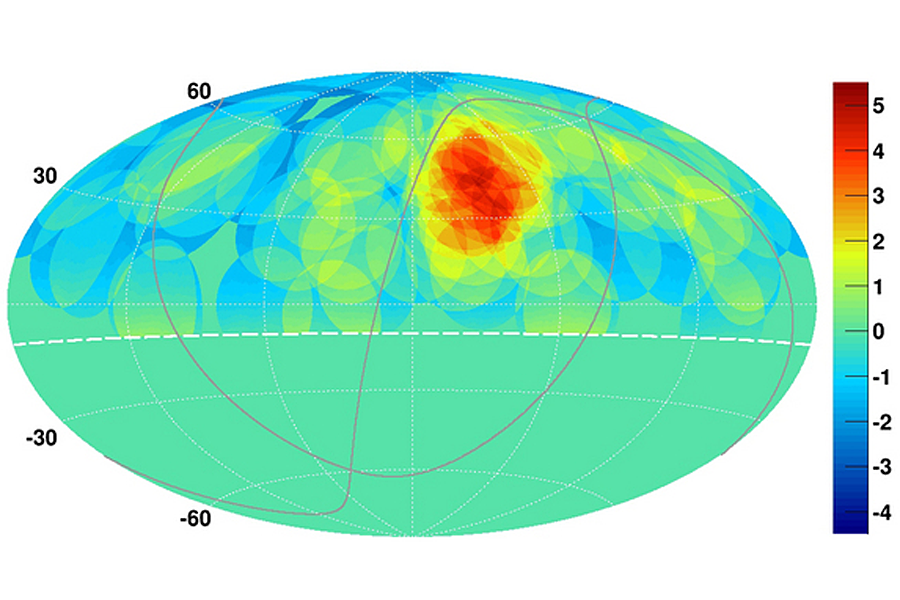Where do cosmic rays come from? The answer could be in the Big Dipper.
Loading...
A hotspot of powerful, ultrahigh-energy particles streams toward Earth from beneath the handle of the Big Dipper constellation. This collection of cosmic rays may help scientists nail down the origin point of the powerful particles, a century-old mystery.
"This puts us closer to finding out the sources — but no cigar yet," Gordon Thomson, of the University of Utah, said in a statement. Thomson is the co-principle investigator for the Telescope Array cosmic ray observatory in southern Utah, which discovered the hotspot, and one of the 125 researchers on the project.
"All we see is a blob in the sky, and inside this blob there is all sorts of stuff — various types of objects — that could be the source," he added. "Now we know where to look." [8 Baffling Astronomy Mysteries]
A hundred-year-old mystery
Gordon worked with an international team of scientists to capture 72 ultrahigh-energy cosmic rays with the Telescope Array over a period of five years. If powerful cosmic ray sources spread evenly across the sky, the resulting waves should also be evenly distributed. Instead, 19 of the detected signals came from a 40-degree circle that makes up only six percent of the sky. The hot spot lies in the constellation Ursa Major, home of the Big Dipper.
"We have a quarter of our events in that circle instead of 6 percent," collaborator Charlie Jui, also from the University of Utah, said in the same statement.
Jui describes the hotspot's location as "a couple of hand widths below the Big Dipper's handle." The region would appear like any other region of the sky to regular optical telescopes.
According to the researchers, the odds that the hotspot is a statistical fluke rather than real are only 1.4 in 10,000.
The hotspot region of the sky lies near the supergalactic plane, which contains local galaxy clusters such as the Ursa Major cluster, the Coma cluster and the Virgo cluster.
The research, which is an international collaboration of over 100 scientists, was recently accepted for publication in the Astrophysical Journal Letters.
Discovered in 1912, cosmic rays are thought to consist of the bare protons of hydrogen nuclei, or the centers of heavier elements. The powerful particles stream in from various regions of the sky, with energies reaching as high as 300 billion billion electron volts. Cosmic rays are classified as "ultrahigh-energy" if they carry the energy of 1 billion billion electron volts, comparable to a fast-pitch baseball.
While low-energy cosmic rays come from stars like the sun over the course of their life or explosive deaths, the origins of more energetic rays remain a mystery.
Suggested progenitors for the more powerful cosmic rays include Active Galactic Nuclei (AGN), where material is sucked into supermassive black holes at the center of galaxies, or gamma-ray bursts from the explosive supernova death of massive stars. Other potential causes include shockwaves from noisy radio galaxies and colliding galaxies. More exotic possibilities include the decay of "cosmic strings," hypothetical one-dimensional defects proposed by string theory.
Ultrahigh-energy cosmic rays stem from outside the Milky Way, but are weakened by interactions with the cosmic microwave background radiation — the leftover fingerprint from the Big Bang that kicked off the universe. As a result, 90 percent of the detected ultrahigh-energy cosmic rays originate within 300 million light-years of Earth.
According to Jui, a separate study currently in progress suggests that the distribution of ultrahigh-energy cosmic rays in the northern sky is related to concentrations of large-scale structures like clusters and superclusters of galaxies.
"It tells us there is at least a good chance these are coming from matter we can see, as opposed to a different class of mechanisms where you are producing these particles with exotic processes," Jui said.
The Telescope Array houses 523 detectors spread over 300 square miles of desert. Physicists hope to make the observatory more sensitive by doubling the number of detectors and quadrupling the area they cover, which should capture more cosmic rays.
"With more events, we are more likely to see structure in that hotspot blob, and that may point us toward the real sources," Jui said.
A preprint of the article may be found online at arXiv.org
Follow us @Spacedotcom, Facebook and Google+. Original article on Space.com.
- Infographic: Cosmic Microwave Background: Big Bang Relic Explained
- Twisted Physics: 7 Mind-Blowing Findings
- The 9 Biggest Unsolved Mysteries in Physics
Copyright 2014 SPACE.com, a TechMediaNetwork company. All rights reserved. This material may not be published, broadcast, rewritten or redistributed.





